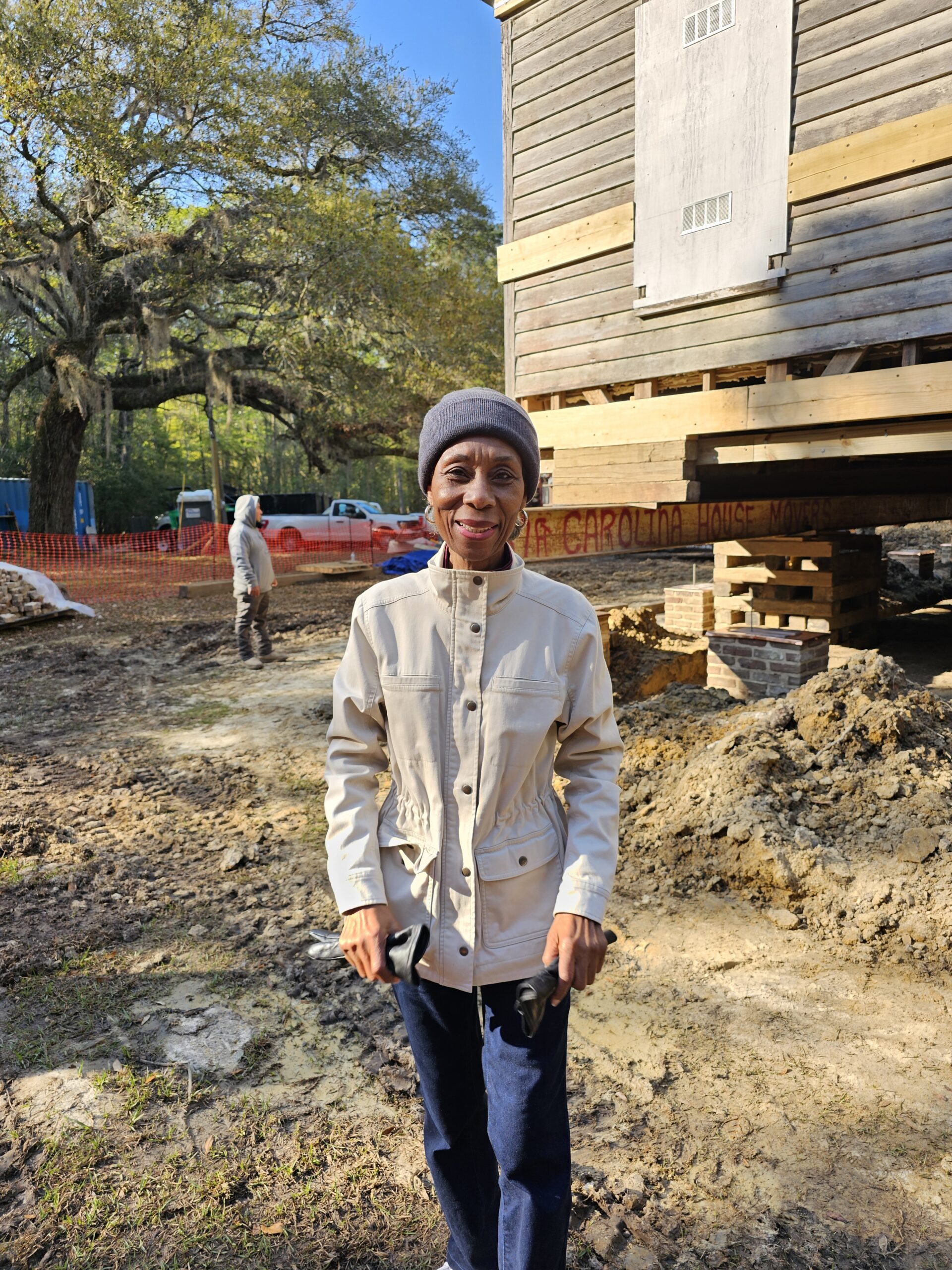Preservation Profiles
July 26, 2024
Cynthia Gibbs: A Passionate Advocate for Taveau Church Restoration
After a long career as a military officer and then a successful small businessperson in and around Washington, D.C., Cynthia Gibbs had plans to build a retirement home for herself back home in Berkeley County.
She still gets back home a lot but those house-building plans have been put on hold while she and other committed volunteers complete the work of restoring an iconic but crumbling landmark: Taveau Church.
Built in the 1830s by enslaved people and in active use until the early 1970s, restoring the beloved structure is now well under way, a process that has included some pivotal moments, including recently watching the building carefully placed onto a new foundation.
“I felt a rush of excitement and relief,” Gibbs says. “Somebody told me that I’d lost my mind getting excited about lifting a 176-year-old structure, but I can get very excited about every brick and board that deals with Taveau.”
Holding Close a Church and the People Who Loved It
Cynthia Gibbs grew up near Taveau Church, in the Moncks Corner-Cordesville area of Berkeley County. She left home for a 21-year career in the Air Force before transitioning into government contracting and organizational consulting.
She always held close her memories of home, including her life at Taveau’s “sister church,” St. Luke UMC, about five miles away. They shared pastors and more, but operated independently until shrinking membership prompted the UMC to shut Taveau and merge it into St. Luke, forming what is now Cordesville UMC.
This merger did not mark the end of Taveau’s significance. Despite the physical closure, the spirit of Taveau lived on through its people and their dedication. Gibbs says one particularly notable figure was Gertrude Lloyd, a trustee who tirelessly raised funds for Taveau’s upkeep. “Miss Gertie really made an impression on me,” Cynthia says. “She loved the church and did everything she could for it.”
A Collaborative Project, Under Budget and Ahead of Schedule
In recent years, efforts to find a permanent solution for Taveau Church’s preservation finally bore fruit. Preservation South Carolina acquired the church in June 2023, and restoration efforts began in earnest. “It was crunch time,” Gibbs says. “The north section of the structure was separating from the main body, and it was on its last leg.”
A collaborative restoration process ramped up quickly and Gibbs has been deeply involved as the chair of the Taveau Legacy Committee. Her dedication is rooted in a profound sense of purpose and community.
“I believe your life has to be about more than just yourself and your views of what you should be doing,” she says. “Restoring a church that is 176 years old is work ordained by God from the beginning of time.”
The restoration aims not only to preserve the building but to revitalize it as a community hub. “We have partnered with Preservation South Carolina to restore the church, and we are ahead of schedule and under budget. I’ve been in project work my whole career, and I can tell you that doesn’t often happen!” she says.
The Vision for a Sacred Corridor
Plans call for the restored church to be used for ecumenical services, family and community events, and cultural gatherings.
Gibbs also envisions Taveau Church as part of a larger “Sacred Corridor” that includes other historical sites, including nearby Strawberry Chapel and Mepkin Abbey, which share location, history, and significance to the African American and broader community here and beyond.
As a tourism draw of its own, Gibbs says, the corridor would highlight the spiritual and cultural heritage of the region, providing a counterbalance to the battlefield histories that dominate South Carolina’s narrative.
“These places speak to our souls. After days of touring battlefields, visitors could come to places like Mepkin, Strawberry and Taveau for reflection and solace,” Gibbs says.
The Oral History Project
A critical component of the restoration is the oral history project launched by the WeGOJA Foundation, aimed at capturing the stories and memories of folks connected to Taveau Church. Gibbs points to the urgency of the endeavor as older generations pass away.
“History in this area is inextricably linked with race, religion, and the land,” Gibbs explains. “We need to get these stories out of people’s heads and onto paper.”
The oral histories will be preserved in the Historic Charleston Foundation’s Margaretta Childs Archive Collection and by the Taveau Legacy Committee. This project also will help inform the interpretive programming at the restored church, further ensuring that the rich history of Taveau is accessible to future generations.
Preserving More Than a Building
For Cynthia Gibbs, the restoration of Taveau Church is about more than preserving a building; it’s about reviving a living piece of her community’s heritage and matching it with its historic partners. “We believe that the Sacred Corridor will be well received, and there will be a lot of interest in visiting these historic churches,” she says. “The battles of this nation were not only won on our battlefields but also on our knees. We can never forget that.”
Gibbs’ passion for Taveau Church will help ensure the church will once again be a place of worship, community, and reflection, and that it will stand as a testament to the enduring spirit and faith of the people who have lived, now live, and will someday live in her beloved Lowcountry community.
“I feel blessed to be part of this opportunity,” she says of her delayed retirement-home plans. “Restoring Taveau is infinitely more exciting and rewarding than anything I had on my little agenda.”

